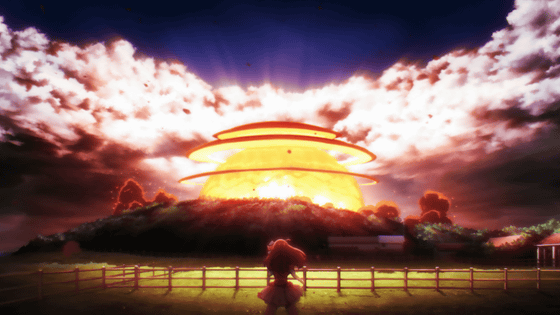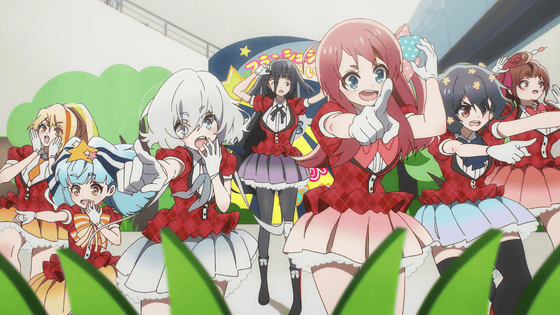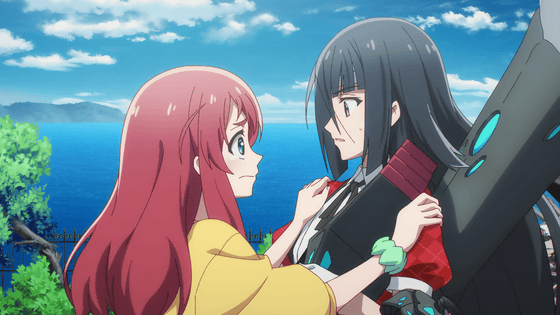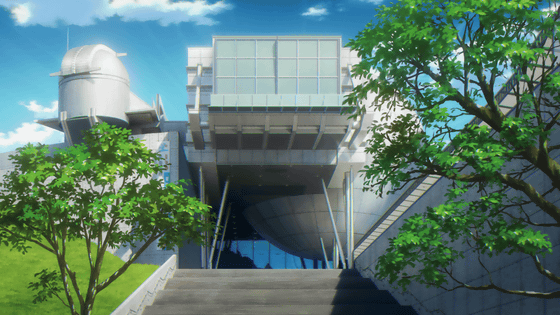Zombies x Idols x Saga, plus aliens, join forces in the movie 'Zombie Land Saga: Yumegin ga Paradise' - an interview with director Konosuke Uda

The anime ' Zombie Land Saga ,' which depicts the resurrection of seven legendary girls, including Sakura Minamoto, a high school student who dreams of becoming an idol, as
The idea of zombies working as idols was already pretty outlandish, but the movie 'Zombie Land Saga: Yumegin ga Paradise' takes things even further, with an alien attack just as Franchouchou prepares to celebrate the Saga Expo as ambassadors, and Yamada Tae, who had previously been a completely selfless zombie, awakens. We spoke to Uda Konosuke, the general director, about how this work came about.
Official website for the movie 'Zombie Land Saga: Yumegin Paradise'
https://zombielandsaga-movie.com/
'Zombie Land Saga Yumegin ga Paradise' 30-second preview _ 10.24 (Fri.) Nationwide release - YouTube
GIGAZINE (hereinafter referred to as G):
Director Uda is also in charge of sound direction for this film. This film is packed with songs and music, and I imagine there were many aspects of the sound that you paid particular attention to. What were the aspects that you paid particular attention to as sound director?
General Director Uda Konosuke (hereinafter referred to as Uda):
Since it was a work with many different elements, I thought about how to add music from an early stage. In the scene where the zombies are revealed, I wanted to create a strict atmosphere, but overall I decided to add music in a style that was more like a 'Sentai' style, and I asked music composer Yasuharu Takanashi to use the 'main theme' for this part.
G:
I see.
Uda:
We decided early on that in some places we would use the first season's opening theme instead of a new song, or bring in an existing song, or use a song from the second season for the zombies' counterattack. We communicated this to Takanashi-san, and we asked him to look at the balance of the background music as we went along. At first, it might sound strange to call it sophisticated, but we were thinking of using classical music to create a 'theatrical' feel, but we changed our minds halfway through and thought, 'That's not it.'

G:
Is that so? That's quite a change of direction (laughs). Were there any detailed instructions given to the cast?
Uda:
Each of the cast members had already played their characters for two seasons in the TV series, so they had a good grasp of their characters, so we didn't have to give them many instructions. However, there were sequences in this film where they had to act emotionally, so I would sometimes tell them on set, 'This is what she's thinking and saying right now.'

G:
This film has a three-person team, with Uda as general director and Sato Takeshi and Ishida Takashi as directors, which I think is a rather unusual system, but how were the roles divided?
Uda:
Certainly, I think it's rare for a group like that. First of all, I'm in the position of 'general director,' but I thought of it as a role to assist someone in the position of director. I've been in the industry for 40 years, so I have quite a bit of experience (laughs).
G:
Oh, I see.
Uda:
Based on that experience, I offered advice like 'You'd do it better this way' or 'Maybe it would be better to do it that way,' and I thought my job was to create an environment that would make it easy for the two directors to work. The reason there were two directors is that Ishida was directing for the first time, Sato is quite young in his career, and there was a lot of work for one person to do alone. Also, each of them had slightly different areas of expertise.
G:
What do each of you specialize in?
Uda:
Sato-kun is rather strong in character acting, while Ishida-kun is particularly skilled in action and creating scenes. I also have experience in filming in the past, so I thought it would be more interesting for the movie if we each played our respective roles. I think MAPPA's President Otsuka had some ideas, but when the script was completed and we asked the two of them to express what they wanted to do, they were well separated and didn't overlap. The amount of material was also roughly halved, so we decided to go with that. My role was to make sure that it didn't become too disjointed.
G:
I see, so it was produced with this general director and two other directors.
Uda:
The script was very long, and if we had done it properly it would have taken about two hours and a half (laughs), but we looked at it as a whole, made adjustments, and made various changes during editing, and somehow managed to get it to fit into a two-hour length.
G:
When I actually saw it, I was impressed that it was exactly two hours long.
Uda:
There were some parts that I cut quite boldly, but if it felt natural when you watched it, I think it was largely down to the editor, Takemiya-san's work. When I thought, 'I'd like to cut this part like this...', he said, 'Okay, let's do it like this,' and edited it really well, which made things a lot easier for me. It's all thanks to Takemiya-san that it didn't feel like I'd forcibly shortened it.
G:
These two hours were unconventional, but was this something that was planned from the early stages of the project? Or was it something that came about after much thought?
Uda:
When it was decided to make a movie version, there was no plan at all. At the end of the final episode of the second season, '
G:
That was a surprise (laughs).
Uda:
So, we started by asking ourselves, 'What should we do from here?' All the staff came together and came up with ideas.
G:
That's because it's extremely difficult...
Uda:
So it took a little while, and I think we kept our fans waiting.
G:
Well, I think that would take a lot of time. I never imagined it would be created after such a hard struggle...
Uda:
Everyone from producers to writers gathered together and asked, 'What should we do?' and, 'What does it mean to be 'Zombie Land Saga'?' (laughs)
G:
(lol)
Uda:
As we packed in all the ideas we had, it became clear at first that it would never end there, and the scriptwriter Murakoshi somehow managed to pull it together, but the script ended up being incredibly long.
G:
In this work, in keeping with the 'Zombie Land Saga' spirit, many real-life landmarks and buildings from Saga Prefecture are featured.
Uda:
Yes, we went around to all of them on location scouting. First, we asked the production team to make a list of places that could be used in the story, and then we visited as many of the candidates as possible. The script hadn't been written yet, so in a sense it was a 'no-plan location shoot.' During the location scouting, we found several places that we thought could be used, such as Yumeginga (Saga Prefectural Space Science Museum) , and we reflected these in the script meetings.

G:
I see, so you got inspiration from the locales and reflected it in the script. So even though various locations appeared, they were naturally incorporated into the story.
Uda:
That's how it is.
G:
It's a monster movie-like piece with a lot of things breaking down, but how did you decide what parts to destroy?
Uda:
For example, when I was filming at the Saga Prefectural Government Office , I asked them during the shoot, 'Is it okay if we destroy something?' and they said, 'Go ahead,' so I destroyed something without any hesitation.
G:
(lol)
Uda:
Yumegin is completely destroyed (lol)
G:
It was truly amazing how completely destroyed it was. Incidentally, you mentioned earlier that as general director you created an environment for the directors to work in, but what kind of work did that involve?
Uda:
When I produced the movie version, I realized that there's no point in putting off problems. They'll just come back to you twice as hard. Also, when you're producing a movie version, you have to put in a different amount of energy than you put into the TV series. I wanted the two directors to focus on the main story as much as possible, so I tried to take charge of the parts outside of the main story as much as possible.
G:
I see, so it certainly has the role of 'preparing the environment.'
Uda:
Also, if there was an image of the video they wanted to create, I would put it on the table so that we could share it with everyone as soon as possible, and try to bring forward solutions as soon as possible, saying, 'If that's the case, wouldn't it be better to do it this way?' We could also prepare the materials in advance, so I was able to help with that.
G:
I guess the idea is to deal with any scenes that are likely to become difficult early on.
Uda:
I tried to talk as much as possible about this kind of awareness to not only the director but all the staff involved in the production.
G:
As General Director Uda, were there any parts of this that you thought would be difficult?
Uda:
An easy example would be the various designs. For example, I wanted to decide on the designs for the spaceships and aliens early on, as they would likely be related to the theme of the film. However, the staff had already started working on this before I even mentioned it, so it wasn't a difficult decision.
G:
What has been a difficult thing you've put off in the past?
Uda:
That happens almost every time. Not only with the movie version, but also with the TV series, things that I thought would 'get fixed later' turned out to be impossible. I've been in the industry for 40 years and have been involved in a variety of projects, but I know firsthand that if you rush ahead without thinking it through, you'll end up in big trouble.
G:
Is making a feature film very different from making a TV series?
Uda:
To me, I don't really feel there's much difference. In fact, the movie version is easier in some ways because you have a wider range of control. With the TV series, there are parts where you have to completely let go and leave things to others, but with the movie version, you can get involved if you want to.
G:
I see. Did Director Uda do anything to encourage the co-directors Ishida and Sato?
Uda:
I had complete confidence in the two directors, Ishida and Sato. We were friends who worked together on the Zombie Land Saga TV series, so they had a high level of understanding of the work and had their own ideas about how things should be done, so I just wanted to let them do what they wanted.
G:
The two directors came up with a lot of ideas that they wanted to do, and as a result of cramming them all together, it ended up being a packed two-hour film.
Uda:
Yes, there were some difficult aspects (laughs), but I think the most important thing was that they were willing to go along with it.
G:
I felt that the film had an incredible sense of drive towards the second half, and I watched wondering how they managed to create something that keeps coming out one after the other.
Uda:
It's all thanks to the hard work of all the staff who were involved from the scenario stage, including the scriptwriter Murakoshi-kun and the producer. Everyone would come up with interesting ideas, and we'd say, 'Okay, let's include that,' or 'That's good too,' but then we'd think, 'This... isn't going to come together?' (laughs), and in the end we even had a meeting to decide whether the structure was okay. That's how well Murakoshi-kun pulled it all together. But that's how 'Zombie Land Saga' is made. From the perspective of the creators, it wasn't a spin-off or anything like that, but a complete sequel to the TV series.
G:
Finally, for those who have read this interview up to this point and are still unsure whether to go see the movie, I would like to hear some words of encouragement.
Uda:
One thing I really paid close attention to was making a movie that even people who are seeing 'Zombie Land Saga' for the first time could enjoy. Of course, you'll enjoy it even more if you've seen the two TV series or read the manga ' Zombie Land Saga Gaiden: The First Zombie ' by character designer Kasumi Fukagawa, but the concept is that it can be enjoyed even by first-time viewers. So, I'd be happy if you would feel free to go to the cinema.
G:
Thank you for talking to me about so many things.
Uda:
thank you very much.
The movie 'Zombie Land Saga: Yumegin ga Paradise' is currently being released nationwide on Friday, October 24, 2025.
[Climax PV] Theatrical version 'Zombie Land Saga: Yumegin ga Paradise' released in cinemas on 10.24 (Fri.) - YouTube
A special interview video with Mitsuishi Kotono, who plays Yamada Tae, who plays a major role in the movie, has also been released.
[Special interview with Omitsuishi Okotono] The movie 'Zombie Land Saga: Yumegin ga Paradise' is now showing to rave reviews! - YouTube
©劇場版ゾンビランドサガ製作委員会
Related Posts:







